Organizational Behavior Analysis and Leadership at CAPCO Report
VerifiedAdded on 2020/02/05
|19
|5762
|52
Report
AI Summary
This report provides a comprehensive analysis of organizational behavior, focusing on the case study of CAPCO, a global IT and management consulting firm. The report begins by examining CAPCO's organizational structure, contrasting its flat structure with the matrix structure, and discussing the influence of organizational culture, particularly the academy culture, on employee performance, motivation, and goal achievement. It then explores the relationship between organizational structure and culture, highlighting their impact on communication, teamwork, and risk-taking. The report further delves into the factors influencing individual behavior in the workplace, such as personality differences and communication, and analyzes various leadership styles, including autocratic, democratic, and laissez-faire approaches, and their impact on employee engagement and productivity. The report also examines organizational theories, including the rational system perspective and scientific management, and their application in managing business operations. Finally, the report identifies factors that can inhibit effective teamwork within an organization, offering insights into how to foster a positive and productive work environment. The report emphasizes the importance of leadership in managing change, motivating employees, and building strong bonds within the organization.
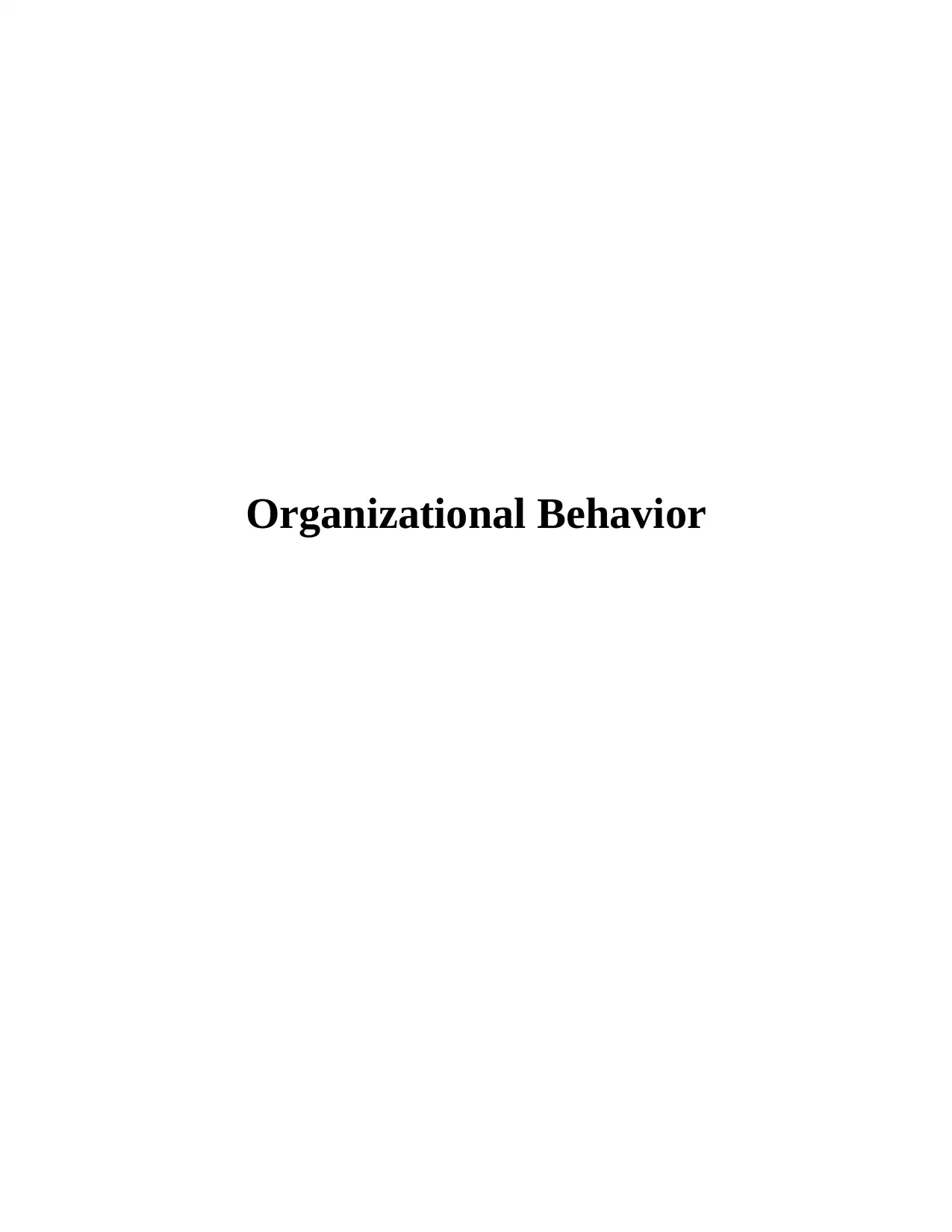
Organizational Behavior
Paraphrase This Document
Need a fresh take? Get an instant paraphrase of this document with our AI Paraphraser
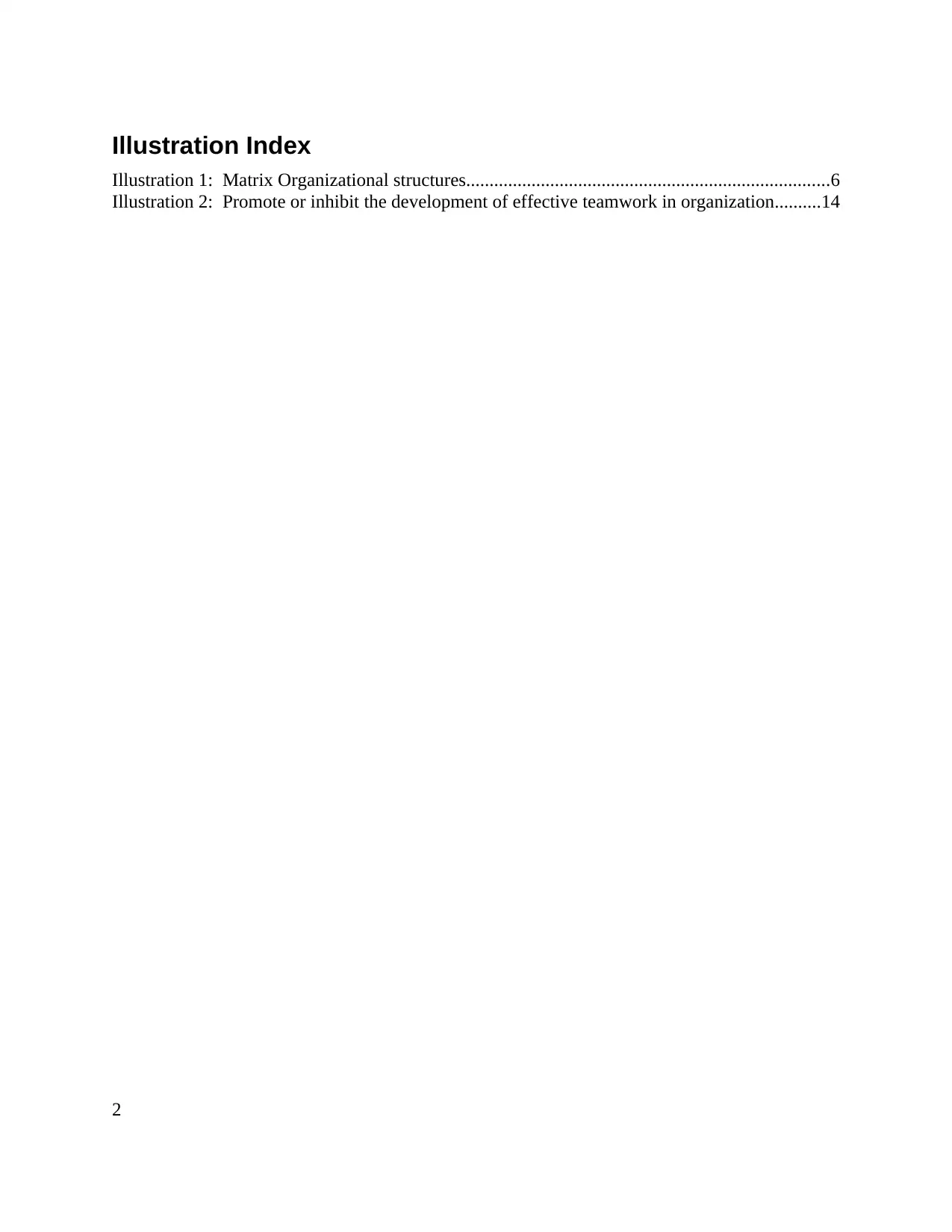
Illustration Index
Illustration 1: Matrix Organizational structures..............................................................................6
Illustration 2: Promote or inhibit the development of effective teamwork in organization..........14
2
Illustration 1: Matrix Organizational structures..............................................................................6
Illustration 2: Promote or inhibit the development of effective teamwork in organization..........14
2
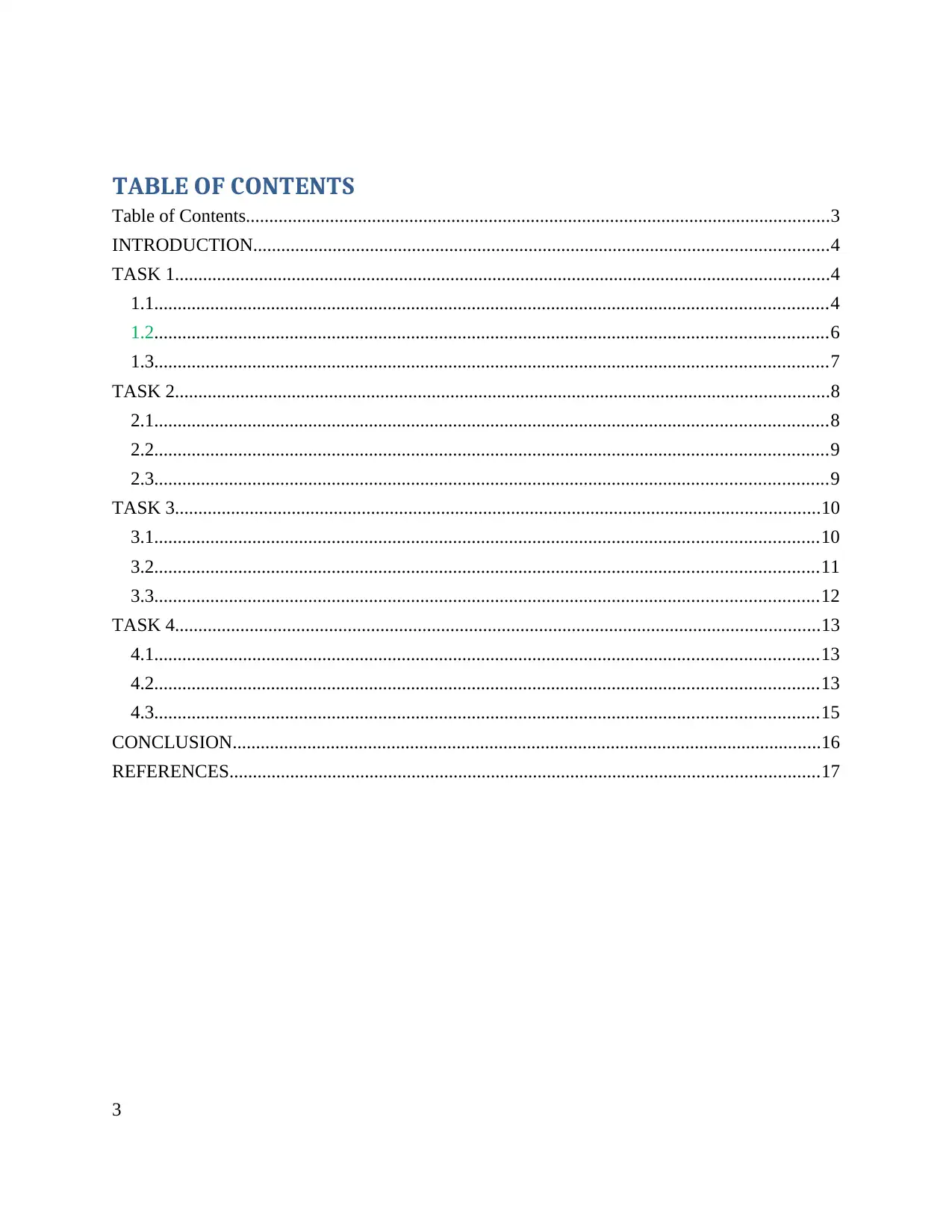
TABLE OF CONTENTS
Table of Contents.............................................................................................................................3
INTRODUCTION...........................................................................................................................4
TASK 1............................................................................................................................................4
1.1................................................................................................................................................4
1.2................................................................................................................................................6
1.3................................................................................................................................................7
TASK 2............................................................................................................................................8
2.1................................................................................................................................................8
2.2................................................................................................................................................9
2.3................................................................................................................................................9
TASK 3..........................................................................................................................................10
3.1..............................................................................................................................................10
3.2..............................................................................................................................................11
3.3..............................................................................................................................................12
TASK 4..........................................................................................................................................13
4.1..............................................................................................................................................13
4.2..............................................................................................................................................13
4.3..............................................................................................................................................15
CONCLUSION..............................................................................................................................16
REFERENCES..............................................................................................................................17
3
Table of Contents.............................................................................................................................3
INTRODUCTION...........................................................................................................................4
TASK 1............................................................................................................................................4
1.1................................................................................................................................................4
1.2................................................................................................................................................6
1.3................................................................................................................................................7
TASK 2............................................................................................................................................8
2.1................................................................................................................................................8
2.2................................................................................................................................................9
2.3................................................................................................................................................9
TASK 3..........................................................................................................................................10
3.1..............................................................................................................................................10
3.2..............................................................................................................................................11
3.3..............................................................................................................................................12
TASK 4..........................................................................................................................................13
4.1..............................................................................................................................................13
4.2..............................................................................................................................................13
4.3..............................................................................................................................................15
CONCLUSION..............................................................................................................................16
REFERENCES..............................................................................................................................17
3
⊘ This is a preview!⊘
Do you want full access?
Subscribe today to unlock all pages.

Trusted by 1+ million students worldwide
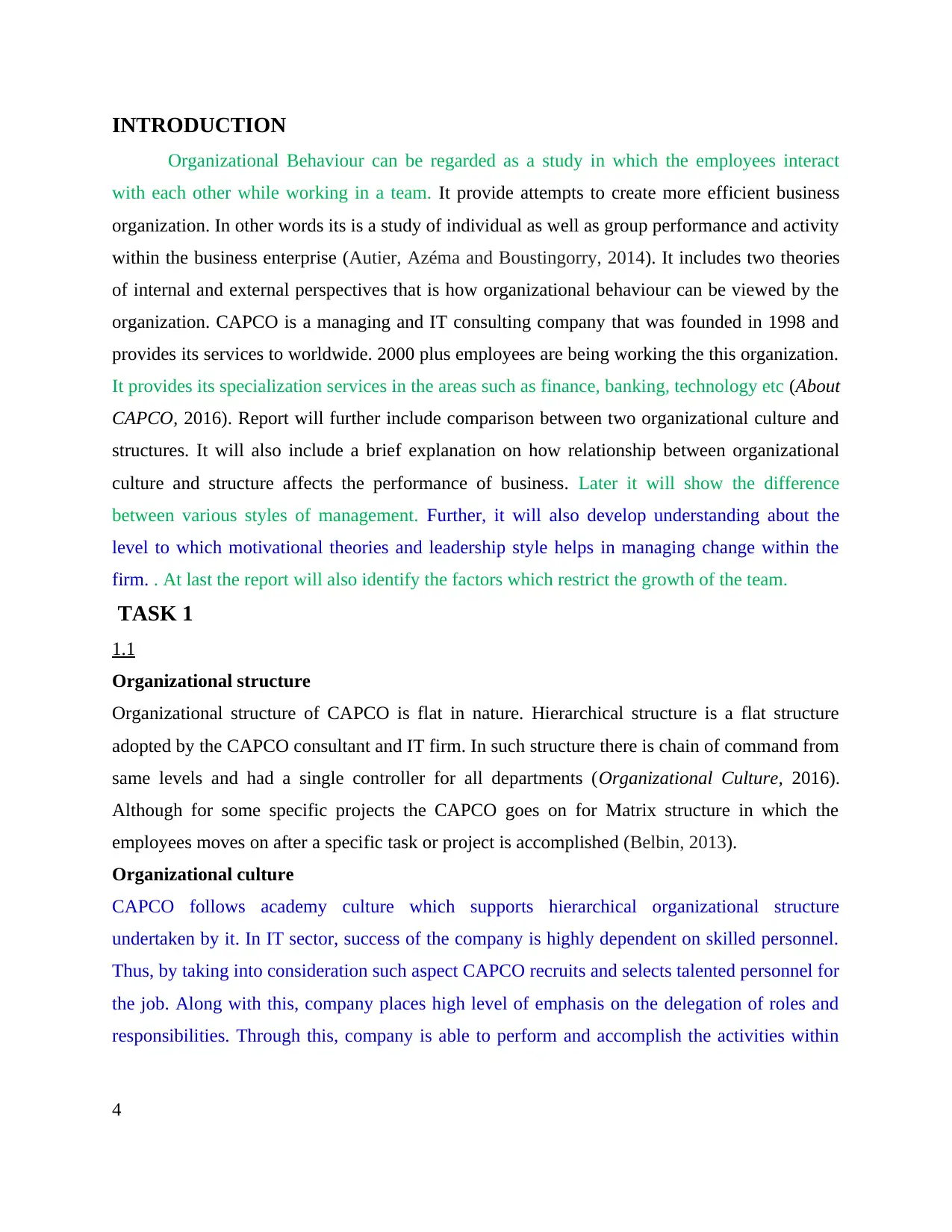
INTRODUCTION
Organizational Behaviour can be regarded as a study in which the employees interact
with each other while working in a team. It provide attempts to create more efficient business
organization. In other words its is a study of individual as well as group performance and activity
within the business enterprise (Autier, Azéma and Boustingorry, 2014). It includes two theories
of internal and external perspectives that is how organizational behaviour can be viewed by the
organization. CAPCO is a managing and IT consulting company that was founded in 1998 and
provides its services to worldwide. 2000 plus employees are being working the this organization.
It provides its specialization services in the areas such as finance, banking, technology etc (About
CAPCO, 2016). Report will further include comparison between two organizational culture and
structures. It will also include a brief explanation on how relationship between organizational
culture and structure affects the performance of business. Later it will show the difference
between various styles of management. Further, it will also develop understanding about the
level to which motivational theories and leadership style helps in managing change within the
firm. . At last the report will also identify the factors which restrict the growth of the team.
TASK 1
1.1
Organizational structure
Organizational structure of CAPCO is flat in nature. Hierarchical structure is a flat structure
adopted by the CAPCO consultant and IT firm. In such structure there is chain of command from
same levels and had a single controller for all departments (Organizational Culture, 2016).
Although for some specific projects the CAPCO goes on for Matrix structure in which the
employees moves on after a specific task or project is accomplished (Belbin, 2013).
Organizational culture
CAPCO follows academy culture which supports hierarchical organizational structure
undertaken by it. In IT sector, success of the company is highly dependent on skilled personnel.
Thus, by taking into consideration such aspect CAPCO recruits and selects talented personnel for
the job. Along with this, company places high level of emphasis on the delegation of roles and
responsibilities. Through this, company is able to perform and accomplish the activities within
4
Organizational Behaviour can be regarded as a study in which the employees interact
with each other while working in a team. It provide attempts to create more efficient business
organization. In other words its is a study of individual as well as group performance and activity
within the business enterprise (Autier, Azéma and Boustingorry, 2014). It includes two theories
of internal and external perspectives that is how organizational behaviour can be viewed by the
organization. CAPCO is a managing and IT consulting company that was founded in 1998 and
provides its services to worldwide. 2000 plus employees are being working the this organization.
It provides its specialization services in the areas such as finance, banking, technology etc (About
CAPCO, 2016). Report will further include comparison between two organizational culture and
structures. It will also include a brief explanation on how relationship between organizational
culture and structure affects the performance of business. Later it will show the difference
between various styles of management. Further, it will also develop understanding about the
level to which motivational theories and leadership style helps in managing change within the
firm. . At last the report will also identify the factors which restrict the growth of the team.
TASK 1
1.1
Organizational structure
Organizational structure of CAPCO is flat in nature. Hierarchical structure is a flat structure
adopted by the CAPCO consultant and IT firm. In such structure there is chain of command from
same levels and had a single controller for all departments (Organizational Culture, 2016).
Although for some specific projects the CAPCO goes on for Matrix structure in which the
employees moves on after a specific task or project is accomplished (Belbin, 2013).
Organizational culture
CAPCO follows academy culture which supports hierarchical organizational structure
undertaken by it. In IT sector, success of the company is highly dependent on skilled personnel.
Thus, by taking into consideration such aspect CAPCO recruits and selects talented personnel for
the job. Along with this, company places high level of emphasis on the delegation of roles and
responsibilities. Through this, company is able to perform and accomplish the activities within
4
Paraphrase This Document
Need a fresh take? Get an instant paraphrase of this document with our AI Paraphraser
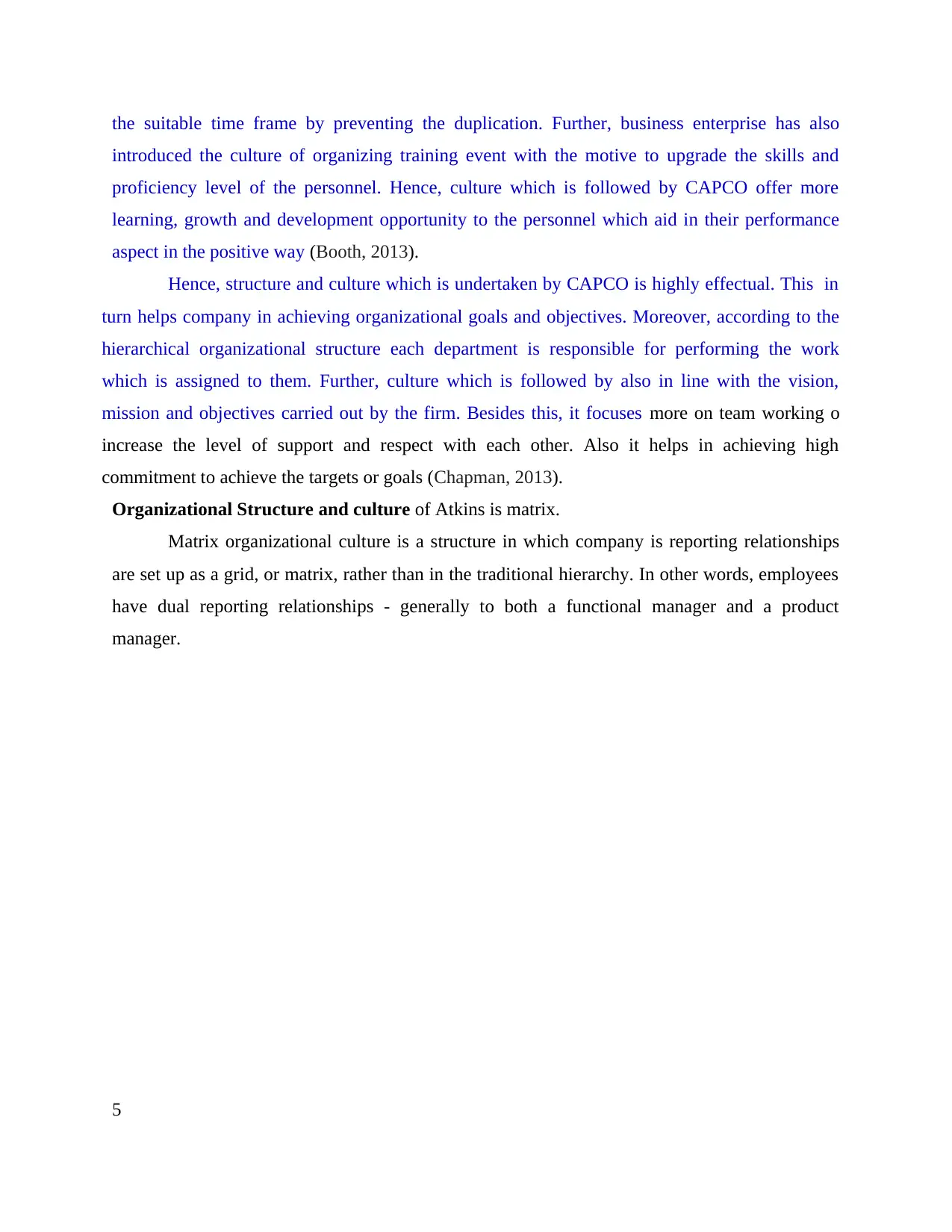
the suitable time frame by preventing the duplication. Further, business enterprise has also
introduced the culture of organizing training event with the motive to upgrade the skills and
proficiency level of the personnel. Hence, culture which is followed by CAPCO offer more
learning, growth and development opportunity to the personnel which aid in their performance
aspect in the positive way (Booth, 2013).
Hence, structure and culture which is undertaken by CAPCO is highly effectual. This in
turn helps company in achieving organizational goals and objectives. Moreover, according to the
hierarchical organizational structure each department is responsible for performing the work
which is assigned to them. Further, culture which is followed by also in line with the vision,
mission and objectives carried out by the firm. Besides this, it focuses more on team working o
increase the level of support and respect with each other. Also it helps in achieving high
commitment to achieve the targets or goals (Chapman, 2013).
Organizational Structure and culture of Atkins is matrix.
Matrix organizational culture is a structure in which company is reporting relationships
are set up as a grid, or matrix, rather than in the traditional hierarchy. In other words, employees
have dual reporting relationships - generally to both a functional manager and a product
manager.
5
introduced the culture of organizing training event with the motive to upgrade the skills and
proficiency level of the personnel. Hence, culture which is followed by CAPCO offer more
learning, growth and development opportunity to the personnel which aid in their performance
aspect in the positive way (Booth, 2013).
Hence, structure and culture which is undertaken by CAPCO is highly effectual. This in
turn helps company in achieving organizational goals and objectives. Moreover, according to the
hierarchical organizational structure each department is responsible for performing the work
which is assigned to them. Further, culture which is followed by also in line with the vision,
mission and objectives carried out by the firm. Besides this, it focuses more on team working o
increase the level of support and respect with each other. Also it helps in achieving high
commitment to achieve the targets or goals (Chapman, 2013).
Organizational Structure and culture of Atkins is matrix.
Matrix organizational culture is a structure in which company is reporting relationships
are set up as a grid, or matrix, rather than in the traditional hierarchy. In other words, employees
have dual reporting relationships - generally to both a functional manager and a product
manager.
5
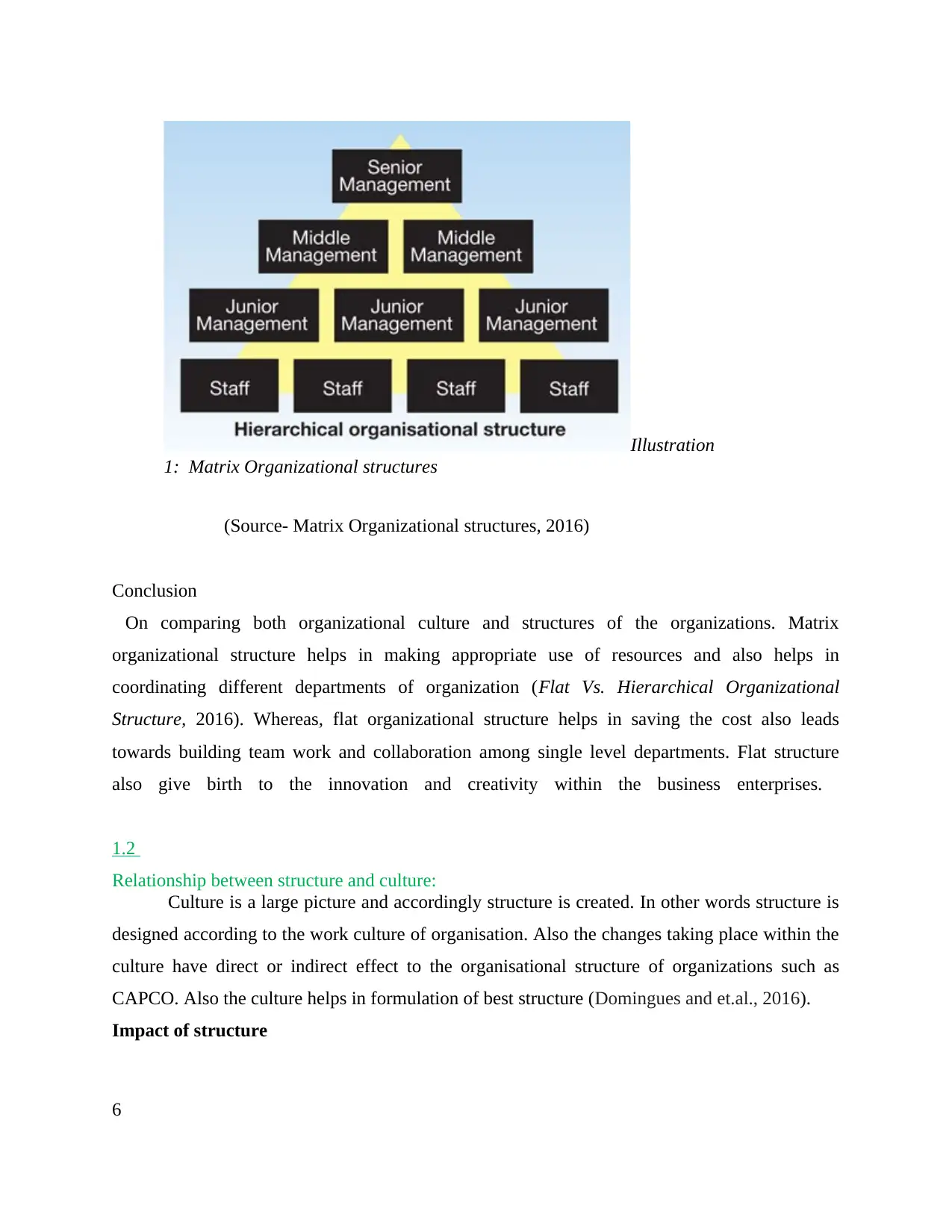
(Source- Matrix Organizational structures, 2016)
Conclusion
On comparing both organizational culture and structures of the organizations. Matrix
organizational structure helps in making appropriate use of resources and also helps in
coordinating different departments of organization (Flat Vs. Hierarchical Organizational
Structure, 2016). Whereas, flat organizational structure helps in saving the cost also leads
towards building team work and collaboration among single level departments. Flat structure
also give birth to the innovation and creativity within the business enterprises.
1.2
Relationship between structure and culture:
Culture is a large picture and accordingly structure is created. In other words structure is
designed according to the work culture of organisation. Also the changes taking place within the
culture have direct or indirect effect to the organisational structure of organizations such as
CAPCO. Also the culture helps in formulation of best structure (Domingues and et.al., 2016).
Impact of structure
6
Illustration
1: Matrix Organizational structures
Conclusion
On comparing both organizational culture and structures of the organizations. Matrix
organizational structure helps in making appropriate use of resources and also helps in
coordinating different departments of organization (Flat Vs. Hierarchical Organizational
Structure, 2016). Whereas, flat organizational structure helps in saving the cost also leads
towards building team work and collaboration among single level departments. Flat structure
also give birth to the innovation and creativity within the business enterprises.
1.2
Relationship between structure and culture:
Culture is a large picture and accordingly structure is created. In other words structure is
designed according to the work culture of organisation. Also the changes taking place within the
culture have direct or indirect effect to the organisational structure of organizations such as
CAPCO. Also the culture helps in formulation of best structure (Domingues and et.al., 2016).
Impact of structure
6
Illustration
1: Matrix Organizational structures
⊘ This is a preview!⊘
Do you want full access?
Subscribe today to unlock all pages.

Trusted by 1+ million students worldwide

1. Advancement in communication techniques- it is important for organisation to make
changes as per the changes occur in the culture. For example- it is required to make
changes by CAPCO in case when there is advancement of communication techniques
takes place in the culture (Farooq, 2015). This will help it in sustaining its position within
the market.
2. Team work efficiency- Appropriate structure helps in building team efficiency within the
business organization. That further result in increase in productivity and profitability of
the firm.
Impact of Culture
1. Risk taking activities accomplishment- In order to remain in the market sometimes the
organisations have to take risk. As such risk taking activities helps the company in
managing or handling the pressure of culture changes. And also assist in attaining
competitive advantage overt various other consultancies firm in the market (Harwiki,
2016).
2. Academy culture places positive impact on the growth and performance aspect of the
firm to the large extent. Moreover, company appoints highly skilled personnel for
performing the business activities and functions. In this way, company is able to provide
customers with innovative IT solutions which helps them in getting the desired level of
outcome or success. Along with this, training session which is conducted by the firm also
places high level of impact on employee motivation and satisfaction. In this way,
employees are encouraged to perform activities in a highly unique or innovative way.
1.3
Business enterprises are formed by individual employees with the motive to achieve
organizational goals and objectives. There are several factors which closely influence the
behavioural aspect of individual at workplace. In the case of CAPCO, numerous factors are
responsible due to which personnel behave differently. Personality differences is one of the main
factors which closely affect the performance of individuals. Moreover, at workplace people are
highly differs in terms of their skills, qualities and educational aspects. In this, company can
manage this situation by employing the suitable style of leadership. If business unit fails to guide
personnel in an appropriate manner then performance of the individual will be negatively
7
changes as per the changes occur in the culture. For example- it is required to make
changes by CAPCO in case when there is advancement of communication techniques
takes place in the culture (Farooq, 2015). This will help it in sustaining its position within
the market.
2. Team work efficiency- Appropriate structure helps in building team efficiency within the
business organization. That further result in increase in productivity and profitability of
the firm.
Impact of Culture
1. Risk taking activities accomplishment- In order to remain in the market sometimes the
organisations have to take risk. As such risk taking activities helps the company in
managing or handling the pressure of culture changes. And also assist in attaining
competitive advantage overt various other consultancies firm in the market (Harwiki,
2016).
2. Academy culture places positive impact on the growth and performance aspect of the
firm to the large extent. Moreover, company appoints highly skilled personnel for
performing the business activities and functions. In this way, company is able to provide
customers with innovative IT solutions which helps them in getting the desired level of
outcome or success. Along with this, training session which is conducted by the firm also
places high level of impact on employee motivation and satisfaction. In this way,
employees are encouraged to perform activities in a highly unique or innovative way.
1.3
Business enterprises are formed by individual employees with the motive to achieve
organizational goals and objectives. There are several factors which closely influence the
behavioural aspect of individual at workplace. In the case of CAPCO, numerous factors are
responsible due to which personnel behave differently. Personality differences is one of the main
factors which closely affect the performance of individuals. Moreover, at workplace people are
highly differs in terms of their skills, qualities and educational aspects. In this, company can
manage this situation by employing the suitable style of leadership. If business unit fails to guide
personnel in an appropriate manner then performance of the individual will be negatively
7
Paraphrase This Document
Need a fresh take? Get an instant paraphrase of this document with our AI Paraphraser
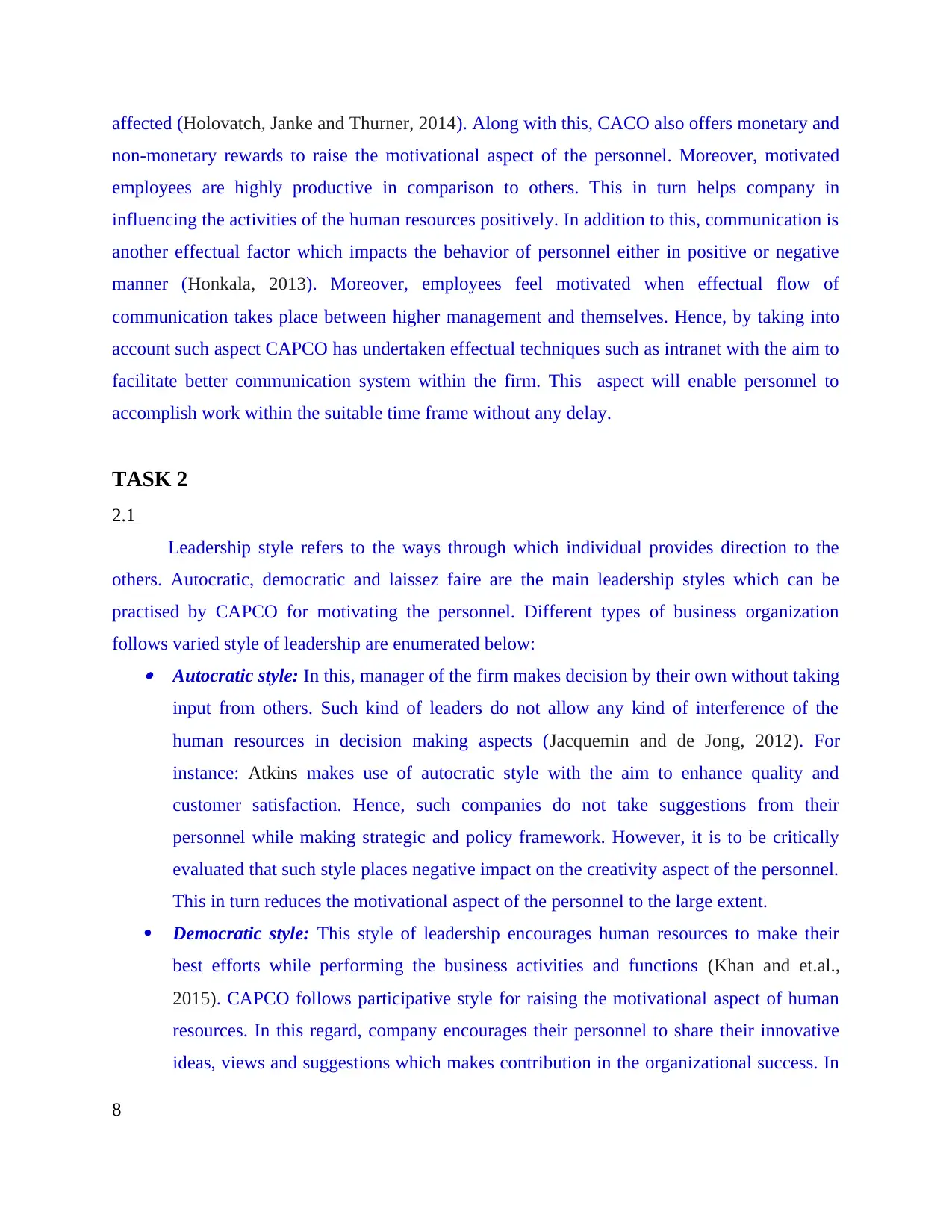
affected (Holovatch, Janke and Thurner, 2014). Along with this, CACO also offers monetary and
non-monetary rewards to raise the motivational aspect of the personnel. Moreover, motivated
employees are highly productive in comparison to others. This in turn helps company in
influencing the activities of the human resources positively. In addition to this, communication is
another effectual factor which impacts the behavior of personnel either in positive or negative
manner (Honkala, 2013). Moreover, employees feel motivated when effectual flow of
communication takes place between higher management and themselves. Hence, by taking into
account such aspect CAPCO has undertaken effectual techniques such as intranet with the aim to
facilitate better communication system within the firm. This aspect will enable personnel to
accomplish work within the suitable time frame without any delay.
TASK 2
2.1
Leadership style refers to the ways through which individual provides direction to the
others. Autocratic, democratic and laissez faire are the main leadership styles which can be
practised by CAPCO for motivating the personnel. Different types of business organization
follows varied style of leadership are enumerated below: Autocratic style: In this, manager of the firm makes decision by their own without taking
input from others. Such kind of leaders do not allow any kind of interference of the
human resources in decision making aspects (Jacquemin and de Jong, 2012). For
instance: Atkins makes use of autocratic style with the aim to enhance quality and
customer satisfaction. Hence, such companies do not take suggestions from their
personnel while making strategic and policy framework. However, it is to be critically
evaluated that such style places negative impact on the creativity aspect of the personnel.
This in turn reduces the motivational aspect of the personnel to the large extent.
Democratic style: This style of leadership encourages human resources to make their
best efforts while performing the business activities and functions (Khan and et.al.,
2015). CAPCO follows participative style for raising the motivational aspect of human
resources. In this regard, company encourages their personnel to share their innovative
ideas, views and suggestions which makes contribution in the organizational success. In
8
non-monetary rewards to raise the motivational aspect of the personnel. Moreover, motivated
employees are highly productive in comparison to others. This in turn helps company in
influencing the activities of the human resources positively. In addition to this, communication is
another effectual factor which impacts the behavior of personnel either in positive or negative
manner (Honkala, 2013). Moreover, employees feel motivated when effectual flow of
communication takes place between higher management and themselves. Hence, by taking into
account such aspect CAPCO has undertaken effectual techniques such as intranet with the aim to
facilitate better communication system within the firm. This aspect will enable personnel to
accomplish work within the suitable time frame without any delay.
TASK 2
2.1
Leadership style refers to the ways through which individual provides direction to the
others. Autocratic, democratic and laissez faire are the main leadership styles which can be
practised by CAPCO for motivating the personnel. Different types of business organization
follows varied style of leadership are enumerated below: Autocratic style: In this, manager of the firm makes decision by their own without taking
input from others. Such kind of leaders do not allow any kind of interference of the
human resources in decision making aspects (Jacquemin and de Jong, 2012). For
instance: Atkins makes use of autocratic style with the aim to enhance quality and
customer satisfaction. Hence, such companies do not take suggestions from their
personnel while making strategic and policy framework. However, it is to be critically
evaluated that such style places negative impact on the creativity aspect of the personnel.
This in turn reduces the motivational aspect of the personnel to the large extent.
Democratic style: This style of leadership encourages human resources to make their
best efforts while performing the business activities and functions (Khan and et.al.,
2015). CAPCO follows participative style for raising the motivational aspect of human
resources. In this regard, company encourages their personnel to share their innovative
ideas, views and suggestions which makes contribution in the organizational success. In
8
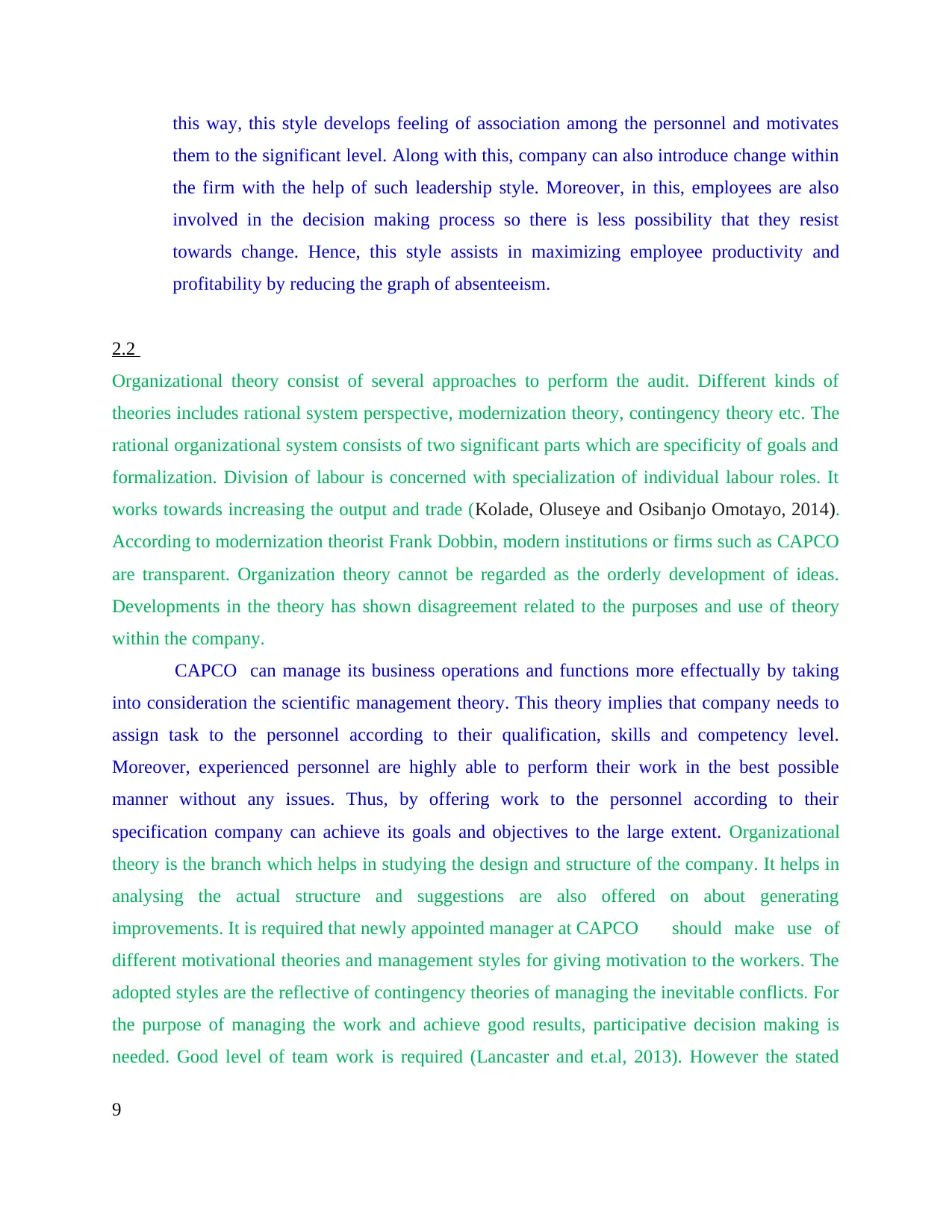
this way, this style develops feeling of association among the personnel and motivates
them to the significant level. Along with this, company can also introduce change within
the firm with the help of such leadership style. Moreover, in this, employees are also
involved in the decision making process so there is less possibility that they resist
towards change. Hence, this style assists in maximizing employee productivity and
profitability by reducing the graph of absenteeism.
2.2
Organizational theory consist of several approaches to perform the audit. Different kinds of
theories includes rational system perspective, modernization theory, contingency theory etc. The
rational organizational system consists of two significant parts which are specificity of goals and
formalization. Division of labour is concerned with specialization of individual labour roles. It
works towards increasing the output and trade (Kolade, Oluseye and Osibanjo Omotayo, 2014).
According to modernization theorist Frank Dobbin, modern institutions or firms such as CAPCO
are transparent. Organization theory cannot be regarded as the orderly development of ideas.
Developments in the theory has shown disagreement related to the purposes and use of theory
within the company.
CAPCO can manage its business operations and functions more effectually by taking
into consideration the scientific management theory. This theory implies that company needs to
assign task to the personnel according to their qualification, skills and competency level.
Moreover, experienced personnel are highly able to perform their work in the best possible
manner without any issues. Thus, by offering work to the personnel according to their
specification company can achieve its goals and objectives to the large extent. Organizational
theory is the branch which helps in studying the design and structure of the company. It helps in
analysing the actual structure and suggestions are also offered on about generating
improvements. It is required that newly appointed manager at CAPCO should make use of
different motivational theories and management styles for giving motivation to the workers. The
adopted styles are the reflective of contingency theories of managing the inevitable conflicts. For
the purpose of managing the work and achieve good results, participative decision making is
needed. Good level of team work is required (Lancaster and et.al, 2013). However the stated
9
them to the significant level. Along with this, company can also introduce change within
the firm with the help of such leadership style. Moreover, in this, employees are also
involved in the decision making process so there is less possibility that they resist
towards change. Hence, this style assists in maximizing employee productivity and
profitability by reducing the graph of absenteeism.
2.2
Organizational theory consist of several approaches to perform the audit. Different kinds of
theories includes rational system perspective, modernization theory, contingency theory etc. The
rational organizational system consists of two significant parts which are specificity of goals and
formalization. Division of labour is concerned with specialization of individual labour roles. It
works towards increasing the output and trade (Kolade, Oluseye and Osibanjo Omotayo, 2014).
According to modernization theorist Frank Dobbin, modern institutions or firms such as CAPCO
are transparent. Organization theory cannot be regarded as the orderly development of ideas.
Developments in the theory has shown disagreement related to the purposes and use of theory
within the company.
CAPCO can manage its business operations and functions more effectually by taking
into consideration the scientific management theory. This theory implies that company needs to
assign task to the personnel according to their qualification, skills and competency level.
Moreover, experienced personnel are highly able to perform their work in the best possible
manner without any issues. Thus, by offering work to the personnel according to their
specification company can achieve its goals and objectives to the large extent. Organizational
theory is the branch which helps in studying the design and structure of the company. It helps in
analysing the actual structure and suggestions are also offered on about generating
improvements. It is required that newly appointed manager at CAPCO should make use of
different motivational theories and management styles for giving motivation to the workers. The
adopted styles are the reflective of contingency theories of managing the inevitable conflicts. For
the purpose of managing the work and achieve good results, participative decision making is
needed. Good level of team work is required (Lancaster and et.al, 2013). However the stated
9
⊘ This is a preview!⊘
Do you want full access?
Subscribe today to unlock all pages.

Trusted by 1+ million students worldwide
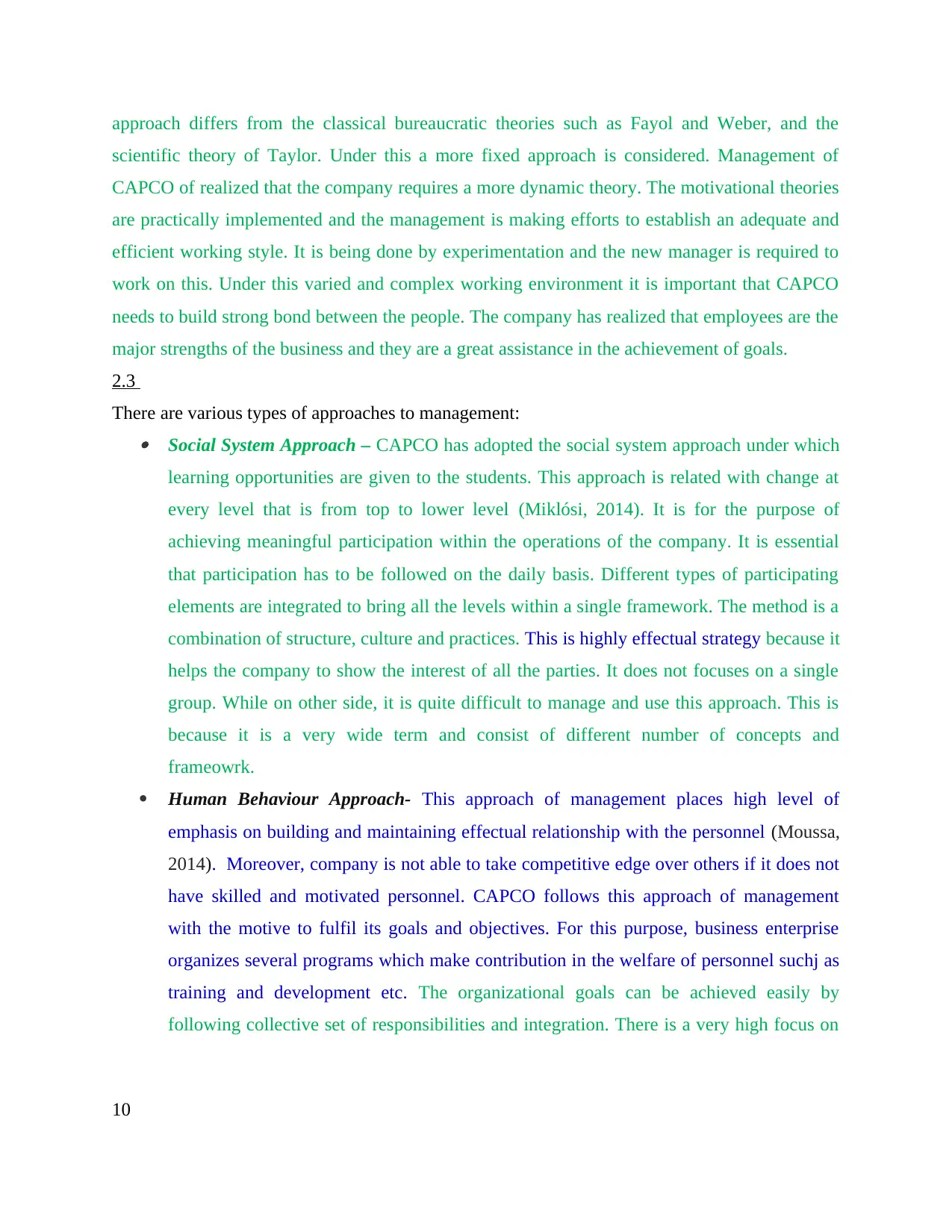
approach differs from the classical bureaucratic theories such as Fayol and Weber, and the
scientific theory of Taylor. Under this a more fixed approach is considered. Management of
CAPCO of realized that the company requires a more dynamic theory. The motivational theories
are practically implemented and the management is making efforts to establish an adequate and
efficient working style. It is being done by experimentation and the new manager is required to
work on this. Under this varied and complex working environment it is important that CAPCO
needs to build strong bond between the people. The company has realized that employees are the
major strengths of the business and they are a great assistance in the achievement of goals.
2.3
There are various types of approaches to management: Social System Approach – CAPCO has adopted the social system approach under which
learning opportunities are given to the students. This approach is related with change at
every level that is from top to lower level (Miklósi, 2014). It is for the purpose of
achieving meaningful participation within the operations of the company. It is essential
that participation has to be followed on the daily basis. Different types of participating
elements are integrated to bring all the levels within a single framework. The method is a
combination of structure, culture and practices. This is highly effectual strategy because it
helps the company to show the interest of all the parties. It does not focuses on a single
group. While on other side, it is quite difficult to manage and use this approach. This is
because it is a very wide term and consist of different number of concepts and
frameowrk.
Human Behaviour Approach- This approach of management places high level of
emphasis on building and maintaining effectual relationship with the personnel (Moussa,
2014). Moreover, company is not able to take competitive edge over others if it does not
have skilled and motivated personnel. CAPCO follows this approach of management
with the motive to fulfil its goals and objectives. For this purpose, business enterprise
organizes several programs which make contribution in the welfare of personnel suchj as
training and development etc. The organizational goals can be achieved easily by
following collective set of responsibilities and integration. There is a very high focus on
10
scientific theory of Taylor. Under this a more fixed approach is considered. Management of
CAPCO of realized that the company requires a more dynamic theory. The motivational theories
are practically implemented and the management is making efforts to establish an adequate and
efficient working style. It is being done by experimentation and the new manager is required to
work on this. Under this varied and complex working environment it is important that CAPCO
needs to build strong bond between the people. The company has realized that employees are the
major strengths of the business and they are a great assistance in the achievement of goals.
2.3
There are various types of approaches to management: Social System Approach – CAPCO has adopted the social system approach under which
learning opportunities are given to the students. This approach is related with change at
every level that is from top to lower level (Miklósi, 2014). It is for the purpose of
achieving meaningful participation within the operations of the company. It is essential
that participation has to be followed on the daily basis. Different types of participating
elements are integrated to bring all the levels within a single framework. The method is a
combination of structure, culture and practices. This is highly effectual strategy because it
helps the company to show the interest of all the parties. It does not focuses on a single
group. While on other side, it is quite difficult to manage and use this approach. This is
because it is a very wide term and consist of different number of concepts and
frameowrk.
Human Behaviour Approach- This approach of management places high level of
emphasis on building and maintaining effectual relationship with the personnel (Moussa,
2014). Moreover, company is not able to take competitive edge over others if it does not
have skilled and motivated personnel. CAPCO follows this approach of management
with the motive to fulfil its goals and objectives. For this purpose, business enterprise
organizes several programs which make contribution in the welfare of personnel suchj as
training and development etc. The organizational goals can be achieved easily by
following collective set of responsibilities and integration. There is a very high focus on
10
Paraphrase This Document
Need a fresh take? Get an instant paraphrase of this document with our AI Paraphraser
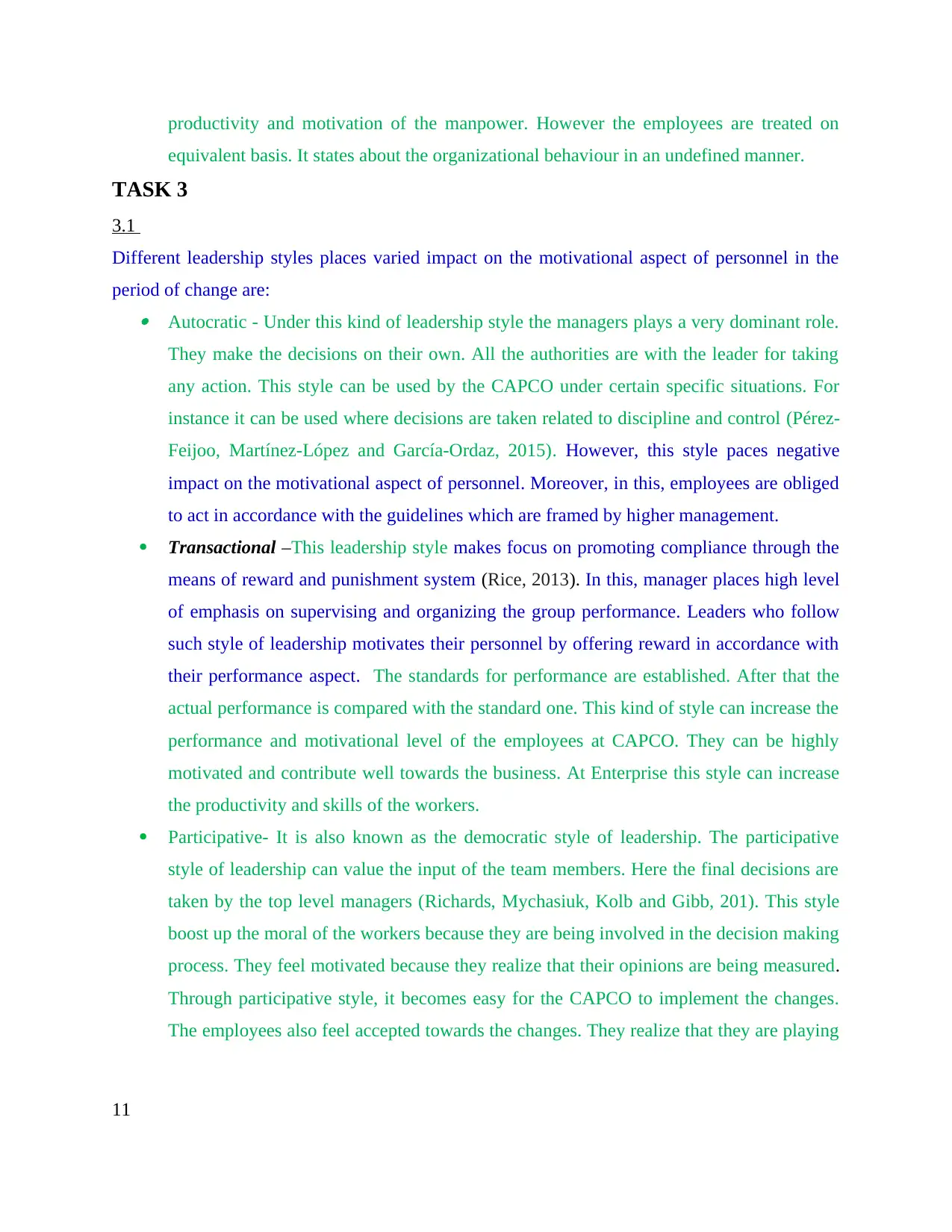
productivity and motivation of the manpower. However the employees are treated on
equivalent basis. It states about the organizational behaviour in an undefined manner.
TASK 3
3.1
Different leadership styles places varied impact on the motivational aspect of personnel in the
period of change are: Autocratic - Under this kind of leadership style the managers plays a very dominant role.
They make the decisions on their own. All the authorities are with the leader for taking
any action. This style can be used by the CAPCO under certain specific situations. For
instance it can be used where decisions are taken related to discipline and control (Pérez-
Feijoo, Martínez-López and García-Ordaz, 2015). However, this style paces negative
impact on the motivational aspect of personnel. Moreover, in this, employees are obliged
to act in accordance with the guidelines which are framed by higher management.
Transactional –This leadership style makes focus on promoting compliance through the
means of reward and punishment system (Rice, 2013). In this, manager places high level
of emphasis on supervising and organizing the group performance. Leaders who follow
such style of leadership motivates their personnel by offering reward in accordance with
their performance aspect. The standards for performance are established. After that the
actual performance is compared with the standard one. This kind of style can increase the
performance and motivational level of the employees at CAPCO. They can be highly
motivated and contribute well towards the business. At Enterprise this style can increase
the productivity and skills of the workers.
Participative- It is also known as the democratic style of leadership. The participative
style of leadership can value the input of the team members. Here the final decisions are
taken by the top level managers (Richards, Mychasiuk, Kolb and Gibb, 201). This style
boost up the moral of the workers because they are being involved in the decision making
process. They feel motivated because they realize that their opinions are being measured.
Through participative style, it becomes easy for the CAPCO to implement the changes.
The employees also feel accepted towards the changes. They realize that they are playing
11
equivalent basis. It states about the organizational behaviour in an undefined manner.
TASK 3
3.1
Different leadership styles places varied impact on the motivational aspect of personnel in the
period of change are: Autocratic - Under this kind of leadership style the managers plays a very dominant role.
They make the decisions on their own. All the authorities are with the leader for taking
any action. This style can be used by the CAPCO under certain specific situations. For
instance it can be used where decisions are taken related to discipline and control (Pérez-
Feijoo, Martínez-López and García-Ordaz, 2015). However, this style paces negative
impact on the motivational aspect of personnel. Moreover, in this, employees are obliged
to act in accordance with the guidelines which are framed by higher management.
Transactional –This leadership style makes focus on promoting compliance through the
means of reward and punishment system (Rice, 2013). In this, manager places high level
of emphasis on supervising and organizing the group performance. Leaders who follow
such style of leadership motivates their personnel by offering reward in accordance with
their performance aspect. The standards for performance are established. After that the
actual performance is compared with the standard one. This kind of style can increase the
performance and motivational level of the employees at CAPCO. They can be highly
motivated and contribute well towards the business. At Enterprise this style can increase
the productivity and skills of the workers.
Participative- It is also known as the democratic style of leadership. The participative
style of leadership can value the input of the team members. Here the final decisions are
taken by the top level managers (Richards, Mychasiuk, Kolb and Gibb, 201). This style
boost up the moral of the workers because they are being involved in the decision making
process. They feel motivated because they realize that their opinions are being measured.
Through participative style, it becomes easy for the CAPCO to implement the changes.
The employees also feel accepted towards the changes. They realize that they are playing
11
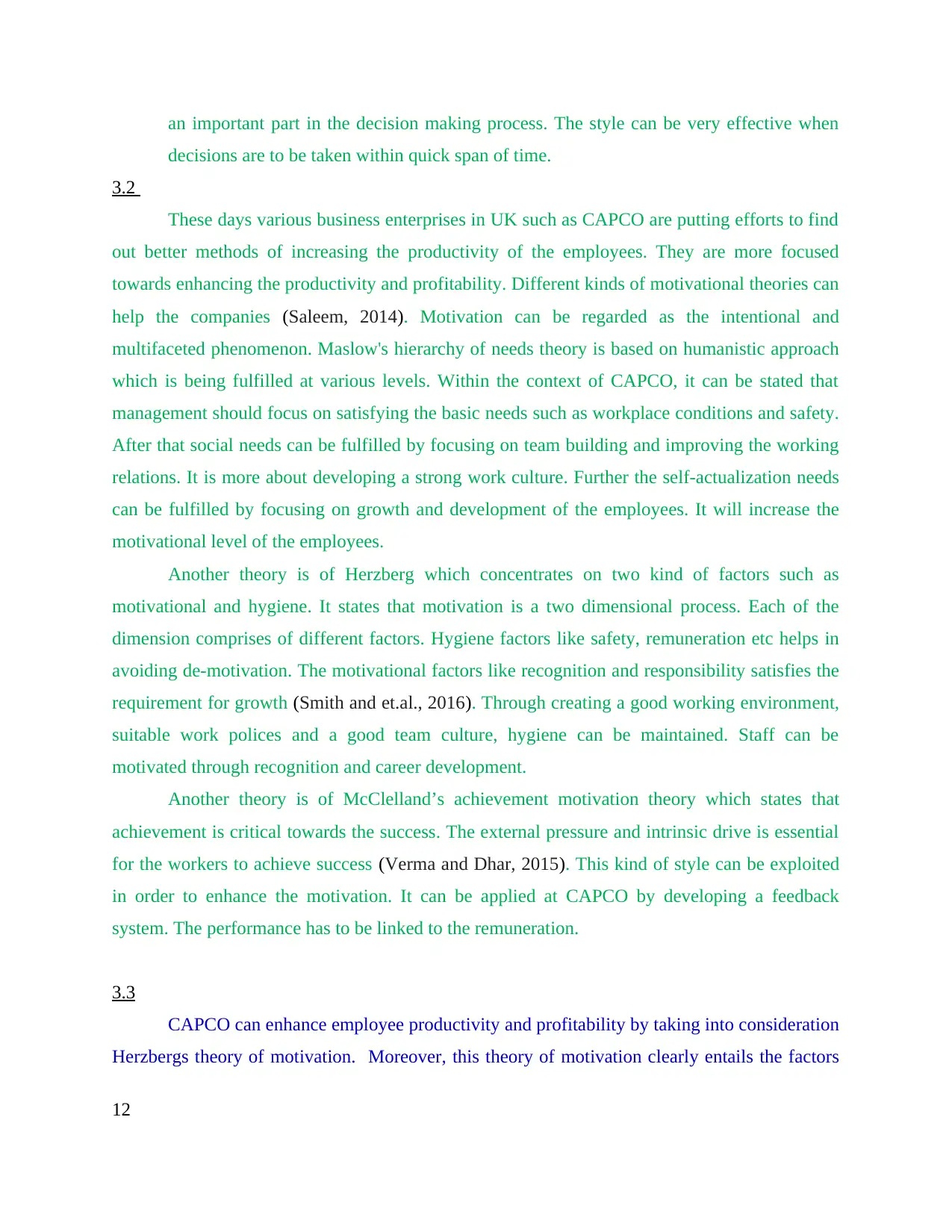
an important part in the decision making process. The style can be very effective when
decisions are to be taken within quick span of time.
3.2
These days various business enterprises in UK such as CAPCO are putting efforts to find
out better methods of increasing the productivity of the employees. They are more focused
towards enhancing the productivity and profitability. Different kinds of motivational theories can
help the companies (Saleem, 2014). Motivation can be regarded as the intentional and
multifaceted phenomenon. Maslow's hierarchy of needs theory is based on humanistic approach
which is being fulfilled at various levels. Within the context of CAPCO, it can be stated that
management should focus on satisfying the basic needs such as workplace conditions and safety.
After that social needs can be fulfilled by focusing on team building and improving the working
relations. It is more about developing a strong work culture. Further the self-actualization needs
can be fulfilled by focusing on growth and development of the employees. It will increase the
motivational level of the employees.
Another theory is of Herzberg which concentrates on two kind of factors such as
motivational and hygiene. It states that motivation is a two dimensional process. Each of the
dimension comprises of different factors. Hygiene factors like safety, remuneration etc helps in
avoiding de-motivation. The motivational factors like recognition and responsibility satisfies the
requirement for growth (Smith and et.al., 2016). Through creating a good working environment,
suitable work polices and a good team culture, hygiene can be maintained. Staff can be
motivated through recognition and career development.
Another theory is of McClelland’s achievement motivation theory which states that
achievement is critical towards the success. The external pressure and intrinsic drive is essential
for the workers to achieve success (Verma and Dhar, 2015). This kind of style can be exploited
in order to enhance the motivation. It can be applied at CAPCO by developing a feedback
system. The performance has to be linked to the remuneration.
3.3
CAPCO can enhance employee productivity and profitability by taking into consideration
Herzbergs theory of motivation. Moreover, this theory of motivation clearly entails the factors
12
decisions are to be taken within quick span of time.
3.2
These days various business enterprises in UK such as CAPCO are putting efforts to find
out better methods of increasing the productivity of the employees. They are more focused
towards enhancing the productivity and profitability. Different kinds of motivational theories can
help the companies (Saleem, 2014). Motivation can be regarded as the intentional and
multifaceted phenomenon. Maslow's hierarchy of needs theory is based on humanistic approach
which is being fulfilled at various levels. Within the context of CAPCO, it can be stated that
management should focus on satisfying the basic needs such as workplace conditions and safety.
After that social needs can be fulfilled by focusing on team building and improving the working
relations. It is more about developing a strong work culture. Further the self-actualization needs
can be fulfilled by focusing on growth and development of the employees. It will increase the
motivational level of the employees.
Another theory is of Herzberg which concentrates on two kind of factors such as
motivational and hygiene. It states that motivation is a two dimensional process. Each of the
dimension comprises of different factors. Hygiene factors like safety, remuneration etc helps in
avoiding de-motivation. The motivational factors like recognition and responsibility satisfies the
requirement for growth (Smith and et.al., 2016). Through creating a good working environment,
suitable work polices and a good team culture, hygiene can be maintained. Staff can be
motivated through recognition and career development.
Another theory is of McClelland’s achievement motivation theory which states that
achievement is critical towards the success. The external pressure and intrinsic drive is essential
for the workers to achieve success (Verma and Dhar, 2015). This kind of style can be exploited
in order to enhance the motivation. It can be applied at CAPCO by developing a feedback
system. The performance has to be linked to the remuneration.
3.3
CAPCO can enhance employee productivity and profitability by taking into consideration
Herzbergs theory of motivation. Moreover, this theory of motivation clearly entails the factors
12
⊘ This is a preview!⊘
Do you want full access?
Subscribe today to unlock all pages.

Trusted by 1+ million students worldwide
1 out of 19
Related Documents
Your All-in-One AI-Powered Toolkit for Academic Success.
+13062052269
info@desklib.com
Available 24*7 on WhatsApp / Email
![[object Object]](/_next/static/media/star-bottom.7253800d.svg)
Unlock your academic potential
Copyright © 2020–2025 A2Z Services. All Rights Reserved. Developed and managed by ZUCOL.





